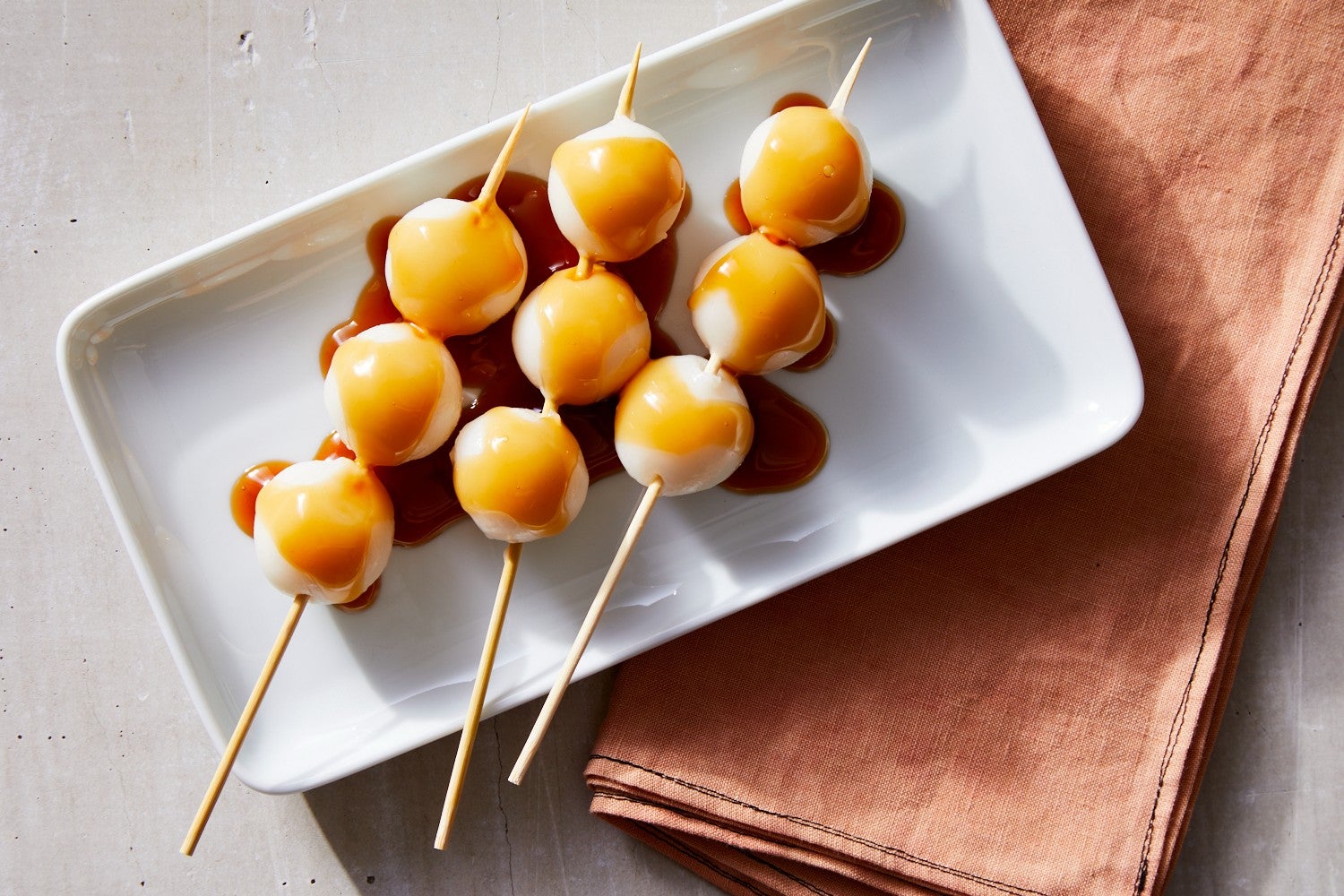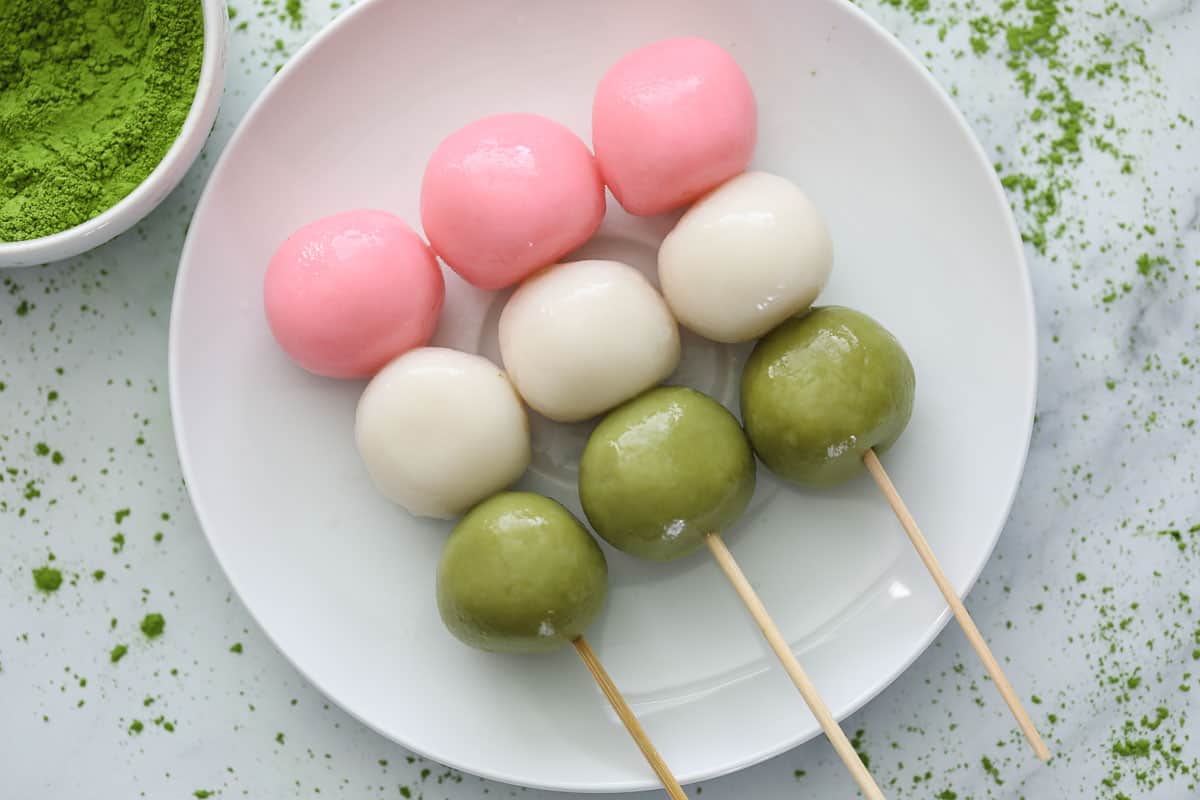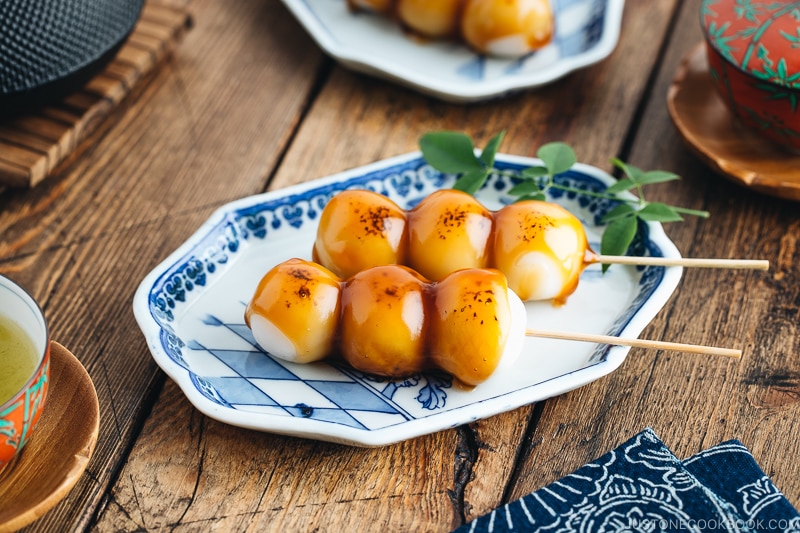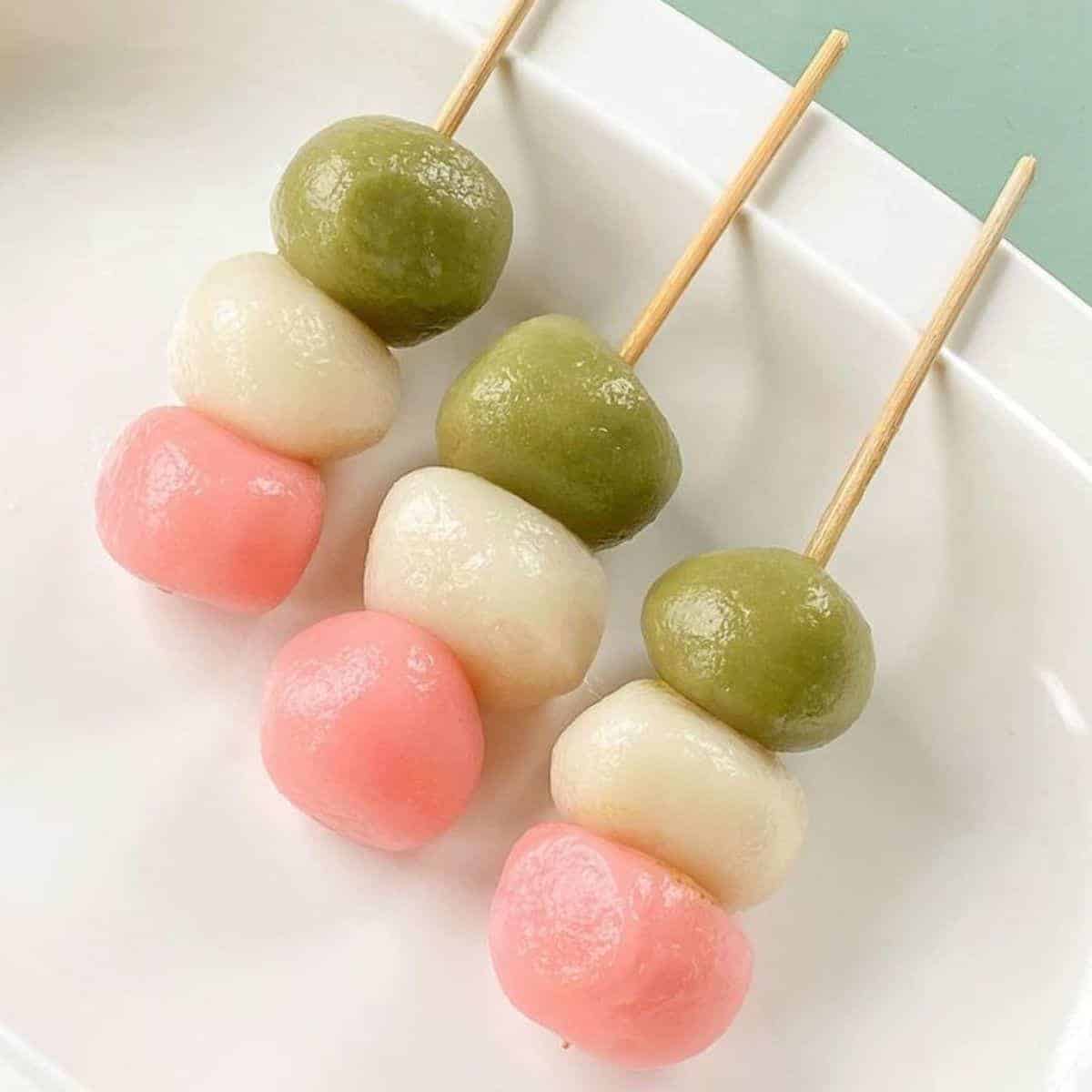With spring in the air, you have got to try this Easy Hanami Dango recipe. Firm, colorful rice balls that are sweet and chewy, this Japanese treat is a must this season.
If you like Asian desserts, you should try these yummy mochi donuts and sweet ube ice cream.
This Hanami Dango recipe only uses a few ingredients and is really easy to follow. Chewy, tender, but still firm, these rice balls are a sweet treat made with rice flour, and brightly colored with pink food coloring and green matcha powder. This dessert is perfect when paired with some Mochi Donuts (VIDEO) or following a savory meal of Hibachi Fried Rice Recipe or Crispy Shrimp Tempura. Enjoy the sweet pink and white balls, as well as the mildly earthy green ones, in this skewered Japanese treat.
Hanami dango is a year round dessert that is enjoyed most commonly during the cherry blossom viewing season in Japan. This coincides with the beginning of spring, and the three colors are said to symbolize the pink of the spring cherry blossoms, the white of the winter snow, and the green of the summer grass. They are made with sweet rice flour and are bright, chewy, soft, and delicious.

Easy Dango Recipe

This Easy Dango Recipe is sweet, chewy, and colorful. This Japanese dessert is just the thing to usher in spring.
Prep: 35min
Total: 45min
Yield: 12
Serving Size: 1 serving
Nutrition Facts: calories 168 kcal, Carbohydrate 38 g, Protein 2 g, Fat 1 g, Saturated Fat 1 g, Sodium 1 mg, Fiber 1 g, Sugar 7 g, unSaturated Fat 2 g, servingSize 1 serving
Ingredients:
- 1 1/3 cup Joshinko non-glutinous rice flour ((1 1/3 cup ) 150 g)
- 1 1/2 cup shiratamako glutinous sweet rice flour ((1 1/2 cup) 200 g)
- 3/4 cup powdered sugar ((optinal) to make it sweeter 75 g)
- 1 1/3 cup hot water
- 1 teaspoon matcha powder (+ 1 tsp water)
- 1 drop pink food coloring
Instruction:
- Before you get started on the dango, you’ll need to soak 12 small bamboo skewers in water.
- Add 150 grams of non-glutinous rice flour (joshinko) into a bowl, along with 200 grams glutinous sweet rice flour (shiratamako). You can also add 75 grams of powdered sugar to make the dango sweeter if you want.
- Then pour in 1 1/3 cup hot water. Begin mixing using a spoon. Once the mixture begins to take shape, use your hands to mold the dango dough together. Depending on how you measured your ingredients can determine the texture of the dough. So you may need to add a little more flour or a little more water to get the correct consistency. The dough should feel similar to clay or play-dough, but a little softer.
- Now, evenly divide the dough into three separate pieces. Place the dough pieces into 3 separate bowls. Add 1 drop of pink food coloring into one piece and work it in.
- The second piece of dough will be the matcha one. So you’ll need to add 1 teaspoon of water to 1 teaspoon of match powder to make a paste. Then add the Matcha paste to that dough and work it in as well.
- The third piece of dough will remain white, so you do not need to add anything to it.
- Now shape the dough into round balls. Each ball should be 20 grams. It’s best to use a kitchen scale when measuring out the weight of the dough. This recipe should make about 36 balls.
- Now bring a pot of water to a boil and begin cooking the white dango balls first. Once you see the balls rise to the top of the pot, continue cooking for another 2 minutes.
- Then use a slotted spoon to transfer the steamed dango and quickly place it into a bowl of ice water.
- Continue doing this for the pink dango and then the green dango last. You want to cook in this order to avoid staining the water and changing the color of the dango.
- Now you can skewer the dango onto the bamboo skewers. Always insert the green ones first, then the white ones in the middle, and the pink ones last. The pink symbolizes spring cherry blossoms, white represents winter snow, and green represents summer grass. They are typically eaten during spring cherry blossom season. You can eat them as they are or add toppings like sweet soy glaze, red bean paste, or matcha paste.
Mitarashi Dango

Mitarashi Dango are traditional Japanese rice dumplings smothered in an irresistibly sweet soy glaze. The dumplings are skewered on a bamboo stick and enjoyed all-year round. Make this street snack right in your own kitchen!
Prep: 30min
Total: 45min
Yield: 5
Serving Size: 1 serving
Nutrition Facts: calories 192 kcal, Carbohydrate 41 g, Protein 3 g, Fat 1 g, Saturated Fat 1 g, Sodium 193 mg, Fiber 1 g, Sugar 6 g, unSaturated Fat 2 g, servingSize 1 serving
Ingredients:
- ⅔ cup joshinko (Japanese rice flour)
- ¾ cup shiratamako (glutinous rice flour/sweet rice flour)
- ⅔ cup boiling water ((joshinko requires boiling water; we will not use the entire amount))
- 7 oz dangoko (Japanese rice dumpling flour) ((団子粉; can be found at Japanese grocery stores))
- ⅔ cup water ((we will not use the entire amount))
- 4 Tbsp sugar
- 2 Tbsp mirin
- 2 Tbsp soy sauce
- 150 ml water ((measure ⅔ cup and remove 2 tsp to be precise))
- 2 Tbsp potato starch or cornstarch
Instruction:
- {‘@type’: ‘HowToStep’, ‘text’: ‘Gather all the ingredients. Joshinko and shiratamako are pictured on the left and dangoko is pictured on the right. Whichever you decide to use, the instructions below are the same.’, ‘name’: ‘Gather all the ingredients. Joshinko and shiratamako are pictured on the left and dangoko is pictured on the right. Whichever you decide to use, the instructions below are the same.’, ‘url’: ‘https://www.justonecookbook.com/mitarashi-dango/#wprm-recipe-59523-step-0-0’, ‘image’: ‘https://www.justonecookbook.com/wp-content/uploads/2019/09/Dango-Ingredients-1.jpg’}
- {‘@type’: ‘HowToStep’, ‘text’: ‘Gather the ingredients for the sweet soy glaze. Soak the skewers in water. You can start boiling a large pot of water on low heat (see Step 8).’, ‘name’: ‘Gather the ingredients for the sweet soy glaze. Soak the skewers in water. You can start boiling a large pot of water on low heat (see Step 8).’, ‘url’: ‘https://www.justonecookbook.com/mitarashi-dango/#wprm-recipe-59523-step-0-1’, ‘image’: ‘https://www.justonecookbook.com/wp-content/uploads/2019/09/Dango-Ingredients-2.jpg’}
- {‘@type’: ‘HowToSection’, ‘name’: ‘To Make the Rice Dumplings’, ‘itemListElement’: [{‘@type’: ‘HowToStep’, ‘text’: ‘Combine the shiratamako and joshinko in a bowl (or add just dangoko in a bowl). Using chopsticks, mix it all together till well blended.’, ‘name’: ‘Combine the shiratamako and joshinko in a bowl (or add just dangoko in a bowl). Using chopsticks, mix it all together till well blended.’, ‘url’: ‘https://www.justonecookbook.com/mitarashi-dango/#wprm-recipe-59523-step-1-0’, ‘image’: ‘https://www.justonecookbook.com/wp-content/uploads/2019/09/Dango-1.jpg’}, {‘@type’: ‘HowToStep’, ‘text’: ‘Stir in the boiling water (or the cold water for the dangoko) a little bit at a time while mixing with chopsticks. Please note: You may not need to use the entire hot water.’, ‘name’: ‘Stir in the boiling water (or the cold water for the dangoko) a little bit at a time while mixing with chopsticks. Please note: You may not need to use the entire hot water.’, ‘url’: ‘https://www.justonecookbook.com/mitarashi-dango/#wprm-recipe-59523-step-1-1’, ‘image’: ‘https://www.justonecookbook.com/wp-content/uploads/2019/09/Dango-2.jpg’}, {‘@type’: ‘HowToStep’, ‘text’: ‘The flours will start to stick together and eventually form clumps. Using your hands, combine the dough into one ball.’, ‘name’: ‘The flours will start to stick together and eventually form clumps. Using your hands, combine the dough into one ball.’, ‘url’: ‘https://www.justonecookbook.com/mitarashi-dango/#wprm-recipe-59523-step-1-2’, ‘image’: ‘https://www.justonecookbook.com/wp-content/uploads/2019/09/Dango-3.jpg’}, {‘@type’: ‘HowToStep’, ‘text’: ‘Knead until the dough becomes smooth. The texture is like squeezing an “earlobe” (that’s how we describe the tenderness of this type of mochi in Japanese).’, ‘name’: ‘Knead until the dough becomes smooth. The texture is like squeezing an “earlobe” (that’s how we describe the tenderness of this type of mochi in Japanese).’, ‘url’: ‘https://www.justonecookbook.com/mitarashi-dango/#wprm-recipe-59523-step-1-3’, ‘image’: ‘https://www.justonecookbook.com/wp-content/uploads/2019/09/Dango-4.jpg’}, {‘@type’: ‘HowToStep’, ‘text’: ‘Form the dough into a ball. Divide the dough into 8 equal pieces.’, ‘name’: ‘Form the dough into a ball. Divide the dough into 8 equal pieces.’, ‘url’: ‘https://www.justonecookbook.com/mitarashi-dango/#wprm-recipe-59523-step-1-4’, ‘image’: ‘https://www.justonecookbook.com/wp-content/uploads/2019/09/Dango-5.jpg’}, {‘@type’: ‘HowToStep’, ‘text’: ‘Then divide each piece into 2 smaller pieces. You will have 16 equal-sized pieces of dough. I always like to weigh mine. Each ball should be 20 grams. You may have some extra dough, but that’s okay.’, ‘name’: ‘Then divide each piece into 2 smaller pieces. You will have 16 equal-sized pieces of dough. I always like to weigh mine. Each ball should be 20 grams. You may have some extra dough, but that’s okay.’, ‘url’: ‘https://www.justonecookbook.com/mitarashi-dango/#wprm-recipe-59523-step-1-5’, ‘image’: ‘https://www.justonecookbook.com/wp-content/uploads/2019/09/Dango-6.jpg’}, {‘@type’: ‘HowToStep’, ‘text’: ‘Shape each of the dough pieces into a smooth, round ball. If the dough is cracking or has some wrinkles, dip the tip of your finger in water and apply a small amount of water to the cracked area to smooth it out. You now have 16 equal-sized dumplings.’, ‘name’: ‘Shape each of the dough pieces into a smooth, round ball. If the dough is cracking or has some wrinkles, dip the tip of your finger in water and apply a small amount of water to the cracked area to smooth it out. You now have 16 equal-sized dumplings.’, ‘url’: ‘https://www.justonecookbook.com/mitarashi-dango/#wprm-recipe-59523-step-1-6’, ‘image’: ‘https://www.justonecookbook.com/wp-content/uploads/2019/09/Dango-7.jpg’}, {‘@type’: ‘HowToStep’, ‘text’: ‘Just before cooking the dumplings, prepare a bowl of iced water. Once the water in the pot is boiling, gently drop each dumpling into the pot with a smooth, continuous arm motion. We want to cook them all at once, while keeping their round shapes. Stir the balls occasionally so they don’t stick to the bottom of the pot.’, ‘name’: ‘Just before cooking the dumplings, prepare a bowl of iced water. Once the water in the pot is boiling, gently drop each dumpling into the pot with a smooth, continuous arm motion. We want to cook them all at once, while keeping their round shapes. Stir the balls occasionally so they don’t stick to the bottom of the pot.’, ‘url’: ‘https://www.justonecookbook.com/mitarashi-dango/#wprm-recipe-59523-step-1-7’, ‘image’: ‘https://www.justonecookbook.com/wp-content/uploads/2019/09/Dango-8-1.jpg’}, {‘@type’: ‘HowToStep’, ‘text’: ‘The dumplings will stay near the bottom of the pot at first, but they will float once they are cooked. When they rise to the top, boil them for an additional 1-2 minutes.’, ‘name’: ‘The dumplings will stay near the bottom of the pot at first, but they will float once they are cooked. When they rise to the top, boil them for an additional 1-2 minutes.’, ‘url’: ‘https://www.justonecookbook.com/mitarashi-dango/#wprm-recipe-59523-step-1-8’, ‘image’: ‘https://www.justonecookbook.com/wp-content/uploads/2019/09/Dango-9.jpg’}, {‘@type’: ‘HowToStep’, ‘text’: ‘Transfer the dumplings to the bowl of iced water.’, ‘name’: ‘Transfer the dumplings to the bowl of iced water.’, ‘url’: ‘https://www.justonecookbook.com/mitarashi-dango/#wprm-recipe-59523-step-1-9’, ‘image’: ‘https://www.justonecookbook.com/wp-content/uploads/2019/09/Dango-10-1.jpg’}, {‘@type’: ‘HowToStep’, ‘text’: ‘Once the dumplings have cooled, drain them well and transfer them to a tray. Tip: Wet the tray so the dumplings don’t stick.’, ‘name’: ‘Once the dumplings have cooled, drain them well and transfer them to a tray. Tip: Wet the tray so the dumplings don’t stick.’, ‘url’: ‘https://www.justonecookbook.com/mitarashi-dango/#wprm-recipe-59523-step-1-10’, ‘image’: ‘https://www.justonecookbook.com/wp-content/uploads/2019/09/Dango-11-1.jpg’}, {‘@type’: ‘HowToStep’, ‘text’: ‘Skewer three pieces onto a bamboo skewer. Continue with the rest of the dumplings and set aside.’, ‘name’: ‘Skewer three pieces onto a bamboo skewer. Continue with the rest of the dumplings and set aside.’, ‘url’: ‘https://www.justonecookbook.com/mitarashi-dango/#wprm-recipe-59523-step-1-11’, ‘image’: ‘https://www.justonecookbook.com/wp-content/uploads/2019/09/Dango-12.jpg’}]}
- {‘@type’: ‘HowToSection’, ‘name’: ‘To Make the Sweet Soy Glaze’, ‘itemListElement’: [{‘@type’: ‘HowToStep’, ‘text’: ‘Combine all the ingredients in a saucepan without turning on the heat.’, ‘name’: ‘Combine all the ingredients in a saucepan without turning on the heat.’, ‘url’: ‘https://www.justonecookbook.com/mitarashi-dango/#wprm-recipe-59523-step-2-0’, ‘image’: ‘https://www.justonecookbook.com/wp-content/uploads/2019/09/Mitarashi-Sauce-1.jpg’}, {‘@type’: ‘HowToStep’, ‘text’: ‘The potato starch/cornstarch will become lumpy if you heat the sauce without stirring it beforehand, so mix all the ingredients together first. Then, turn on the heat and continue to whisk.’, ‘name’: ‘The potato starch/cornstarch will become lumpy if you heat the sauce without stirring it beforehand, so mix all the ingredients together first. Then, turn on the heat and continue to whisk.’, ‘url’: ‘https://www.justonecookbook.com/mitarashi-dango/#wprm-recipe-59523-step-2-1’, ‘image’: ‘https://www.justonecookbook.com/wp-content/uploads/2019/09/Mitarashi-Sauce-2.jpg’}, {‘@type’: ‘HowToStep’, ‘text’: ‘Keep whisking continuously, as the mixture can become thick suddenly.’, ‘name’: ‘Keep whisking continuously, as the mixture can become thick suddenly.’, ‘url’: ‘https://www.justonecookbook.com/mitarashi-dango/#wprm-recipe-59523-step-2-2’, ‘image’: ‘https://www.justonecookbook.com/wp-content/uploads/2019/09/Mitarashi-Sauce-3.jpg’}, {‘@type’: ‘HowToStep’, ‘text’: ‘When the sauce becomes thick, remove the saucepan from the heat and transfer the sauce to a container or bowl. If you are making this sauce ahead of time, remove it from the heat before the consistency gets too thick because the moisture will evaporate and thicken the sauce as it cools.’, ‘name’: ‘When the sauce becomes thick, remove the saucepan from the heat and transfer the sauce to a container or bowl. If you are making this sauce ahead of time, remove it from the heat before the consistency gets too thick because the moisture will evaporate and thicken the sauce as it cools.’, ‘url’: ‘https://www.justonecookbook.com/mitarashi-dango/#wprm-recipe-59523-step-2-3’, ‘image’: ‘https://www.justonecookbook.com/wp-content/uploads/2019/09/Mitarashi-Sauce-4.jpg’}]}
- {‘@type’: ‘HowToSection’, ‘name’: ‘To Serve’, ‘itemListElement’: [{‘@type’: ‘HowToStep’, ‘text’: ‘Optional: If you have a kitchen torch, you can give the Mitarashi Dango a little bit of char for a grilled taste. You can also grill them over direct heat (if you are going to place them on a wire rack, grease it first, as the dumplings tend to stick). You can use a broiler to char the dumplings or use a nonstick frying pan to pan-fry the surface of the dango.’, ‘name’: ‘Optional: If you have a kitchen torch, you can give the Mitarashi Dango a little bit of char for a grilled taste. You can also grill them over direct heat (if you are going to place them on a wire rack, grease it first, as the dumplings tend to stick). You can use a broiler to char the dumplings or use a nonstick frying pan to pan-fry the surface of the dango.’, ‘url’: ‘https://www.justonecookbook.com/mitarashi-dango/#wprm-recipe-59523-step-3-0’, ‘image’: ‘https://www.justonecookbook.com/wp-content/uploads/2019/09/Dango-13.jpg’}, {‘@type’: ‘HowToStep’, ‘text’: ‘Pour the sweet soy glaze on top and serve immediately.’, ‘name’: ‘Pour the sweet soy glaze on top and serve immediately.’, ‘url’: ‘https://www.justonecookbook.com/mitarashi-dango/#wprm-recipe-59523-step-3-1’, ‘image’: ‘https://www.justonecookbook.com/wp-content/uploads/2019/09/Dango-14-Mitarashi.jpg’}]}
- {‘@type’: ‘HowToSection’, ‘name’: ‘To Store’, ‘itemListElement’: [{‘@type’: ‘HowToStep’, ‘text’: ‘Option 1: After you form the dough into round dumplings, you can store the uncooked dumplings in a single layer in an airtight container and freeze up to a month. When you use them, boil the frozen dango without defrosting.’, ‘name’: ‘Option 1: After you form the dough into round dumplings, you can store the uncooked dumplings in a single layer in an airtight container and freeze up to a month. When you use them, boil the frozen dango without defrosting.’, ‘url’: ‘https://www.justonecookbook.com/mitarashi-dango/#wprm-recipe-59523-step-4-0’}, {‘@type’: ‘HowToStep’, ‘text’: ‘Option 2: After boiling and cooling the dumplings, pat them dry and pack them so they don’t touch each other into an airtight container. Freeze for up to a month. When you use them, microwave or boil until they are warm.’, ‘name’: ‘Option 2: After boiling and cooling the dumplings, pat them dry and pack them so they don’t touch each other into an airtight container. Freeze for up to a month. When you use them, microwave or boil until they are warm.’, ‘url’: ‘https://www.justonecookbook.com/mitarashi-dango/#wprm-recipe-59523-step-4-1’}]}
Dango Recipe (Hanami, Mitarashi, Bocchan)

Here, we’ll teach you how to make dango or sweet Japanese dumplings in 3 different ways! This recipe has steps for hanami, mitarashi, and bocchan dango. Our recipe serves five sticks and makes sixteen to seventeen dough balls.
Prep: 30min
Total: 45min
Yield: 5
Serving Size: 1 serving
Nutrition Facts: calories 166 kcal, Carbohydrate 36 g, Protein 3 g, Fat 1 g, Sodium 2 mg, Fiber 1 g, servingSize 1 serving
Ingredients:
- ⅔ cup joshinko ((Japanese rice flour))
- ¾ cup shiratamako ((sweet glutinous rice flour))
- ⅔ cup warm water
- 1 tsp matcha powder
- 1 tsp water
- 1 drop pink food colouring
- ½ cup anko red bean paste
- 2 egg yolks
- 1 tsp matcha powder
- 1 tsp water
- 4 tsps sugar
- 2 tsps mirin
- 2 tsps soy sauce
- 150 ml water
- 2 tsps potato starch or cornstarch
Instruction:
- Skewer three pieces into a bamboo skewer. You are ready to serve if you do not have additional flavours or colouring to add!
- For bocchan, crack the eggs, separate the yolks and mix the dough ball into them. The egg yolk will stain the dough yellow.
- Then turn on the heat and keep whisking until you get a thick sauce. You can now remove the saucepan from the heat and transfer the sauce to a container or bowl. Dip the skewered dumplings into the sauce or glaze them with it.
Hanami Dango

Let’s make Hanami dango with shiratamako at home to celebrate the arrival of spring!
Prep: 10min
Total: 20min
Yield: 6
Serving Size: 1 serving
Nutrition Facts: calories 79 kcal, Carbohydrate 16 g, Protein 1 g, Sugar 4 g, servingSize 1 serving
Ingredients:
- 90 g Glutinous rice flour (*1 equivalent to ¼ cup)
- 90 g Water (*2 or Silken tofu read above post)
- 2 tbs white sugar
- 1/4 tsp Matcha powder
- A drop of Pink colouring
Instruction:
- Place the shiratamako, water or silken tofu, and sugar in a large bowl and mix well until it forms a dough with a wooden spatula.
- Divide the dough into three equal portions.
- Add the Matcha powder into one of the dough portions and knead until the dough turns green.
- Add a couple of small drops of pink or red food colouring into one of the other dough portions and knead into the dough until it turns light pink.
- Roll each ball of dough (green, pink, and white) into 6 uniform-sized balls.
- Boil a pot of water and add the Dango balls.
- Once the Dango floats to the surface of the water leave them cooking for a few minutes more, then scoop them out and put them into a bowl of cold water to halt the cooking process.
- Place one green dango, one white dango, and one pink dango onto a skewer and repeat until all the Dango are gone then serve!
Hanami Dango Dumplings /花見団子 / Bunny Dango Monster Hunter
FAQ
What does dango taste like?
What is the difference between dango and mochi?
What is dango dessert made of?
Is dango eaten warm or cold?
